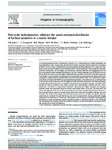Fine-scale hydrodynamics influence the spatio-temporal distribution of harbour porpoises at a coastal hotspot
| dc.contributor.author | Jones, AR | |
| dc.contributor.author | Hosegood, P | |
| dc.contributor.author | Wynn, RB | |
| dc.contributor.author | De Boer, MN | |
| dc.contributor.author | Butler-Cowdry, S | |
| dc.contributor.author | Embling, CB | |
| dc.date.accessioned | 2015-11-25T13:25:00Z | |
| dc.date.available | 2015-11-25T13:25:00Z | |
| dc.date.issued | 2014-08-11 | |
| dc.identifier.issn | 0079-6611 | |
| dc.identifier.issn | 1873-4472 | |
| dc.identifier.uri | http://hdl.handle.net/10026.1/3831 | |
| dc.description.abstract |
The coastal Runnelstone Reef, off southwest Cornwall (UK), is characterised by complex topography and strong tidal flows and is a known high-density site for harbour porpoise (. Phocoena phocoena); a European protected species. Using a multidisciplinary dataset including: porpoise sightings from a multi-year land-based survey, Acoustic Doppler Current Profiling (ADCP), vertical profiling of water properties and high-resolution bathymetry; we investigate how interactions between tidal flow and topography drive the fine-scale porpoise spatio-temporal distribution at the site. Porpoise sightings were distributed non-uniformly within the survey area with highest sighting density recorded in areas with steep slopes and moderate depths. Greater numbers of sightings were recorded during strong westward (ebbing) tidal flows compared to strong eastward (flooding) flows and slack water periods. ADCP and Conductivity Temperature Depth (CTD) data identified fine-scale hydrodynamic features, associated with cross-reef tidal flows in the sections of the survey area with the highest recorded densities of porpoises. We observed layered, vertically sheared flows that were susceptible to the generation of turbulence by shear instability. Additionally, the intense, oscillatory near surface currents led to hydraulically controlled flow that transitioned from subcritical to supercritical conditions; indicating that highly turbulent and energetic hydraulic jumps were generated along the eastern and western slopes of the reef. The depression and release of isopycnals in the lee of the reef during cross-reef flows revealed that the flow released lee waves during upslope currents at specific phases of the tidal cycle when the highest sighting rates were recorded. The results of this unique, fine-scale field study provide new insights into specific hydrodynamic features, produced through tidal forcing, that may be important for creating predictable foraging opportunities for porpoises at a local scale. Information on the functional mechanisms linking porpoise distribution to static and dynamic physical habitat variables is extremely valuable to the monitoring and management of the species within the context of European conservation policies and marine renewable energy infrastructure development. | |
| dc.format.extent | 30-48 | |
| dc.language | en | |
| dc.language.iso | en | |
| dc.publisher | Elsevier BV | |
| dc.subject | 37 Earth Sciences | |
| dc.subject | 3708 Oceanography | |
| dc.subject | 14 Life Below Water | |
| dc.subject | 15 Life on Land | |
| dc.title | Fine-scale hydrodynamics influence the spatio-temporal distribution of harbour porpoises at a coastal hotspot | |
| dc.type | journal-article | |
| dc.type | Review | |
| plymouth.author-url | http://gateway.webofknowledge.com/gateway/Gateway.cgi?GWVersion=2&SrcApp=PARTNER_APP&SrcAuth=LinksAMR&KeyUT=WOS:000343795800003&DestLinkType=FullRecord&DestApp=ALL_WOS&UsrCustomerID=11bb513d99f797142bcfeffcc58ea008 | |
| plymouth.volume | 128 | |
| plymouth.publication-status | Published | |
| plymouth.journal | PROGRESS IN OCEANOGRAPHY | |
| dc.identifier.doi | 10.1016/j.pocean.2014.08.002 | |
| pubs.publication-status | PDF (Open Access paper) - Publishers print Available under License Creative Commons Attribution.http://creativecommons.org/licenses/by/2.5/ | |
| plymouth.organisational-group | /Plymouth | |
| plymouth.organisational-group | /Plymouth/Faculty of Science and Engineering | |
| plymouth.organisational-group | /Plymouth/Faculty of Science and Engineering/School of Biological and Marine Sciences | |
| plymouth.organisational-group | /Plymouth/PRIMaRE Publications | |
| plymouth.organisational-group | /Plymouth/REF 2021 Researchers by UoA | |
| plymouth.organisational-group | /Plymouth/REF 2021 Researchers by UoA/UoA07 Earth Systems and Environmental Sciences | |
| plymouth.organisational-group | /Plymouth/Research Groups | |
| plymouth.organisational-group | /Plymouth/Research Groups/Marine Institute | |
| plymouth.organisational-group | /Plymouth/Users by role | |
| plymouth.organisational-group | /Plymouth/Users by role/Academics | |
| plymouth.organisational-group | /Plymouth/Users by role/Researchers in ResearchFish submission | |
| dcterms.dateAccepted | 2014-08-05 | |
| dc.identifier.eissn | 1873-4472 | |
| dc.rights.embargoperiod | No embargo | |
| rioxxterms.versionofrecord | 10.1016/j.pocean.2014.08.002 | |
| rioxxterms.licenseref.uri | http://www.rioxx.net/licenses/all-rights-reserved | |
| rioxxterms.licenseref.startdate | 2014-08-11 | |
| rioxxterms.type | Journal Article/Review |


